
Protecting Sri Lanka’s elephant population
Mitigating the Human-Elephant Conflict and reducing the alarming rate at which elephants are currently being killed (about four per week) requires addressing various aspects of the problem simultaneously without resorting to stop gap, piece-meal solutions, asserts Srilal Miththapala.
In an interview with Daily FT, the passionate wildlife enthusiast, untiring advocate of conservation of wild elephants and experienced tourism professional points out that such a major multi-faceted campaign to address the HEC will need State patronage and leadership, together with a strong private sector partnership.
“Until there is a will from the Government to handle the HEC as a top priority in a holistic manner, I am afraid nothing much will happen, and we are doomed to see our wild elephant population eventually dying off,” he warns.
Following are excerpts:
Q: Elephants gather in Minneriya during the dry season due to the relative availability of water in the area. Are there signs that this pattern is being (or will be) disrupted due to climate change and more intense bouts of drought? If so what effect will this have on the park and on the elephants?
A: So far there has been no appreciable change to be noticed, even though there have been some changes in the weather patterns. The most critical element in this annual phenomena is the natural ebb and flow of the reservoir annually. Just as much as the reservoir getting filled during the rainy season is important, the gradually drying up of the reservoir during the draught is also important.
When the water recedes it leaves behind fertile, moist soil where lush grass quickly sprouts, which is good nutritious food for the wild elephants. So apart from changing weather patterns and other natural causes, if the reservoir is in any way artificially filled by channelling water from other sources for additional storage for irrigation purposes, it will affect this natural annual ‘ebb and flow’, resulting in disastrous consequences for ‘The Gathering’.
Q: You’ve written about the revenue making potential of ‘The Gathering’ but can Minneriya National Park handle an influx of tourists without deteriorating conditions for wildlife?
A: Yes I did estimate that ‘The Gathering’ is now worth about more than Rs. 1 billion annually. But I never did imply that it can go on increasing forever. There is a limit to the growth, and visitor influx has to be curtailed once there are signs of over-visitation and disruptions to the elephants’ feeding behaviour. I am told that this year the situation has reached unprecedented levels and that something needs to be done very urgently to curb over-visitation.
Q: Some environmentalists would argue that commercialisation of wildlife is categorically wrong and leads to abuse, as seen in Dehiwala Zoo or Yala. In your opinion, are profit and conservation compatible? What steps can we take to maintain a balance?
A: I think conservation and commercialisation can be compatible, but only if managed and balanced extremely carefully and ethically. The problem arises in maintaining this delicate balance. There must be no exploitation, no unethical use of captive animals, and above all they have to be well cared for and used for educational, and conservational purposes only.
Q: The Government has recently approved keeping a pool of around 35 elephants for peraheras – a solution that you have vocally supported in the past. Do you see this as a permanent solution or one step in phasing out elephants in religious and cultural activities?
A: Yes, I have supported this, and it has turned into a controversial issue now! So let me explain. Peraheras and elephants are a rich cultural and religious tradition in Sri Lanka, coming down from historical times. Having said that, traditions also need to change gradually overtime, as perceptions and the social environment changes… but not overnight. So I believe over a period of time, the custom of using tame elephants in pageants will, and should stop. Until then we need an interim solution.
We have a captive herd of some 80 odd elephants at the Pinnawela Elephant Orphanage or PEO as it is known, most of whom have lived all their life in captivity. There is no way these animals could be rehabilitated and released into the wild, because they will just not know how to fend for themselves. So what some of us have suggested is to handpick a group of suitable elephants, from this source (PEO), with the correct temperament, and physique, to be trained and used in pageants as an interim measure. The orphanage could earn valuable income which can in turn be used for upkeep and improvement of its facilities.
As time goes by, if the human elephant conflict is managed and mitigated well, there will be fewer orphaned elephant calves from the wild, and ‘input’ to the PEO will reduce, and gradually such elephants available for ‘pageant duty’ will also reduce. Hopefully by that time people would have realised that having hundreds of elephants in pageants is not viable option, and we may see peraheras with just a few customary elephants in the procession, together with one with special characteristics to carry the relics.
Q: On what basis do you think these elephants should be selected and how should their numbers be replenished over the years? Furthermore, how do we ensure the physical and mental wellbeing of elephants who will be driven around the country and exposed to loud festivals on a regular basis?
A:As indicated earlier, they should be handpicked to ensure that only good, healthy individuals with the correct docile temperament are chosen. They should each have a dedicated fulltime mahout, who will ensure that the animal is properly transported, looked after and managed during such pageants. Proper transport facilities should be provided as a part of the hiring package offered by the PEO, and at all times the PEO should be able to monitor the elephants. There could be roster in place to ensure that some animals are not overused. Of course all this requires very strict guidelines and monitoring, which in itself is another challenge.
Q: Recently the issue of starving elephants has come up. What are some of the driving factors for this and what can be done in the short and medium term to address this problem?
A:I think you are referring to the issue brought up recently at a talk about elephants in wildlife parks being malnourished. This problem actually stems from the mismanagement of National Parks and alienation of elephants from other forest areas. Contrary to what many people believe, elephants are not particularly fond of heavily forested areas. They prefer scrub grass lands and other secondary vegetation. When they are confined to National Parks, and when translocated elephants from other areas are also introduced or herds driven into the parks, without any consideration of carrying capacity, these food sources dwindle and the elephants slowly start getting malnourished.
Large-scale proper management of the flora of the park has to be carried out in a symmetric manner to help re-generate these food sources that the elephants need. A prime example of this is the Uda Walawe National Park (UWNP), which had one of the best thriving and healthy populations of wild elephants in Sri Lanka. Overcapacity has gradually eroded the environment and food sources in the park, and with no interventions to stimulate re-growth of the eroded grassland, it is now beginning to show, with several emaciated looking individuals being sighted now.
Over 65% of the wild elephant population of the island live outside protected areas, which often have much richer and nutritious food sources. The easiest ‘solution’ to the HEC in the name of conservation is to drive these elephants into the parks, further aggravating the problems within the parks… when actually the need is to manage these animals outside the protected areas itself.
This is a good example to show that the HEC cannot be solved by a few quick-fix solutions. There has to be a management plan for these peripheral areas, many of which do not come under the purview of the Department of Wildlife Conservation, but under the Forest Department, which then opens out complex issues of jurisdiction and responsibility.
Q: Finally, do you feel the tide is turning when it comes to elephant conservation efforts? Is Sri Lanka progressing in terms of preserving if not growing its elephant population? What are some of the policies and factors responsible for this?
A: Unfortunately I do not think the tide is turning at all. There is still no cohesive and holistic approach to tackle the Human Elephant Conflict (HEC), with only typical ‘kneejerk’ responses to problems. Take for example the recent incident where four elephants were knocked down by a train and killed. The immediate solution is fitting infra-red cameras on trains. This problem has been discussed so many times before, analysed and solutions suggested.
There are a whole range of issues which have to be addressed here. The attitude of the engine drivers, the speeds of the trains and stopping distances, visibility around bends and line of sight, etc. I know that Dr. Sumith Pilapitiya travelled on a train several years ago to see for himself the issues and understand the complexities. What a few us concluded was that no ONE solution would work, and that there needed to be a multi-pronged, cohesive solution, addressing both the hard and soft issues.
Similarly mitigating the HEC, and reducing the alarming rate at which elephants are currently being killed (about four per week) requires addressing various aspects of the problem simultaneously, in a cohesive, focused, organised sustained manner, without resorting to stop gap, piece-meal solutions. Such a major multi-faceted campaign to address the HEC will need State patronage and leadership, together with a strong private sector partnership.
So until there is a will from the Government to handle the HEC as a top priority in a holistic manner, I am afraid nothing much will happen, and we are doomed to see our wild elephant population eventually dying off. –
Source : 29/08/2016 Dailly FT http://www.ft.lk/article/564056/Protecting-Sri-Lanka-s-elephant-population#sthash.oNgiT8C3.dpuf

The trumpet has sounded, at judgment we stand
On the railway track last week in Chettikulam there was a horrible elephant tragedy which needs to be a trumpet call as to how serious Sri Lanka is in its commitment to protecting and promoting biodiversity — the world environmental theme for this year.
On August 18, three baby elephants and a mother elephant were killed when they were hit by the Mannar night mail train heading towards Colombo. Reports say a herd of about twenty five elephants had attempted to cross the railway track and seven elephants were hit by the train which was apparently running faster than the speed permitted in such areas where engine drivers have been told to go slow because elephants may cross the track. Three mutilated bodies were found around the same place while fourth had been dragged for about 400 metres along the track. Villagers say three other injured elephants had run into their jungle homelands.
With last week’s slaughter the number of priceless elephants killed by trains this year has risen to 11. Environmental investigators say that elephants killed on rail tracks are mainly those deprived of both homelands and food and thus roam around just to survive in the conditions that wickedly selfish people have created for them.
In a report published in the
yesterday out investigative journalists pointed out how selfish people had grabbed the habitats of the elephants — the priceless treasures and long time sacred kings of our jungles. Therefore it is not surprising that the fight for space has become a key factor in the human-elephant conflict, and it has tragically led to the deaths of about 200 elephants every year.
Marauding elephants also claim the lives of about 50 people annually, mainly by roaring and raging through villages built near their habitats. According to the latest census the number of Sri Lankan elephants has drastically dropped to about 7,000 compared to about 12,000 some hundred years ago. Obviously the elephants cannot provide a solution to this crisis. The government and the people especially movements committed to the conservation of biodiversity need to act urgently and effectively to find the solution and save our precious elephants from possible extinction.
As for elephants killed on rail tracks, the Railway authorities have said they have a plan to install thermo-cameras where through the heat emitted by the elephants, the driver would get a warning.
Jayantha Jayewardene, Managing Trustee of the Biodiversity and Elephant Conservation Trust, says elephants panic when they hear high speed trains. By tooting the horn from a distance the elephants are alerted and can move away. Mr. Jayawardene says, sometime ago the Wildlife Department deployed an official in the train driver’s cabin to prevent the driver getting drunk and being careless. But eventually it was found that both were getting drunk and the victim was the elephant.
Deadly drunken jokes apart, for a long-term solution the government needs to move faster than the drunken driver’s train and strictly implement the laws on deforestation. World environment crusaders insist that in the battle against climate change and the destruction of the eco-balance and biodiversity, priority must be given to stop deforestation. The government must not allow any housing or other projects in habitats which belong to the elephants. Without such an eco-friendly policy and commitment to diversity there cannot be sustainable development.
Besides the killing of elephants in train accidents or in the human elephant conflict there are also the heartless poachers. In Africa these wicked gangs are going after rhinos whose tusks are known to be more valuable than gold. In Sri Lanka also we see such poachers, many of them with political patronage. They kill the majestic tuskers to make a huge profit not realising or caring that they are destroying one of our great treasures.
We hope the government will act fast and firmly against all these elephant killers and make it clear to them that the trumpet has sounded and at judgment they stand.
Source 26/08/2016 Daily mirror : http://www.dailymirror.lk/114748/The-trumpet-has-sounded-at-judgment-we-stand#sthash.1pLv61gx.dpuf

Farmland, forests and fauna suffer in mountain fires
Forest fires across the central part of the country, aggravated by dry conditions, have left hundreds of acres of trees destroyed and brought suffering and death to wild animals.
Firefighters continue to tackle a huge blaze in Ravana Ella, Badulla, with nearly 20 acres of land laid waste by fires spreading in the mountainous regions.
The Department of Wildlife Conservation says nearly 60 hectares (148 acres) of farmland have been destroyed in forest fires so far this year.
There have been several fires in the past two weeks, with incidents being reported from the Naula, Laggala, Rantota, Dambulla, Gallewela, Sigiriya, Gampola, Nawalapitiya Hatton, Maskeliya, Bogawantalawa and Talawakelle, the Conservator-General of Forests, Anura Sathurusinghe said.
Fires were difficult to control because they were breaking out in remote areas and being aided by the dry weather.
Mr. Sathurusinghe said the blazes were caused by various factors including hunters setting fire to an area of a forest so that animals could be captured and killed when they flee to another area.
The grassland areas of Kandy and Matale are the areas most prone to forest fires. Since dry weather conditions can convert even green vegetation into inflammable fuel even a simple spark can create a big forest fire, he said.
“Particularly during the dry season, people light fires for hunting, chena cultivation and also for cattle grazing.
“These fires are difficult to control and severely damage forest biodiversity,” he said.
Almost all forest fires in Sri Lanka are man-made, through accident or design.
Forest Department sources say farmers sometimes set dead grass alight to clear land to grow fresh grass for cattle, and these fires can spread to adjacent forests. Farmers also burn down degraded forests to clear land for cultivation.
“Forest fires severely damage the eco system: they affect the animals’ breathing, destroy plants and create soil erosion. Amphibians, reptiles and insects are directly affected,” an official of the Environment Conservation Trust said.
“Forest fires directly destroy the seed bank of a plant,” the official added. “These contain seeds needed for the next generation of plants and as a result of these fires many native plants are destroyed.”
Source :Sundaytimes http://www.sundaytimes.lk/160821/news/farmland-forests-and-fauna-suffer-in-mountain-fires-205634.html
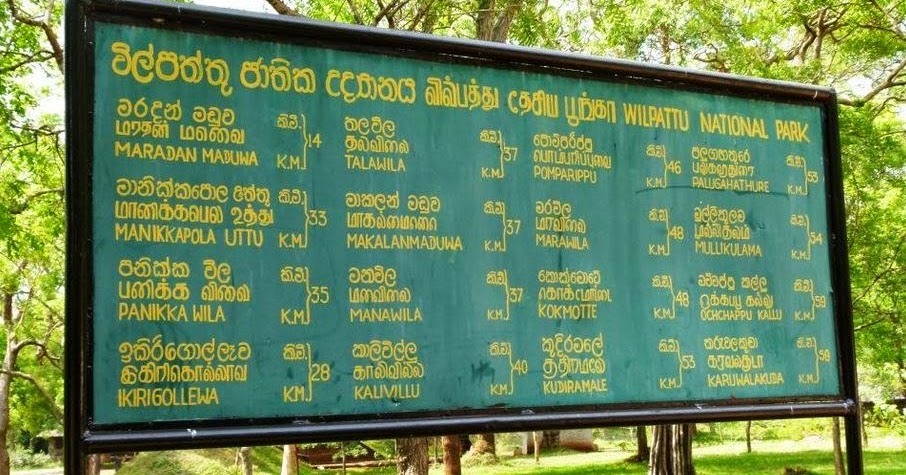
Construction and forest clearing in Wilpattu National Park violates conservation laws
WNPS expresses deep concern
The Fauna and Flora Protection Ordinance No 2 of 1937 (as amended, hereinafter at times referred to as the FFPO) which governs the legal administration of the Protected Areas of Sri Lanka clearly states that there can be no development activity or clearing of the habitat within National Parks (Section 6).
According to information available, the Pallenkandal Shrine was built over 300 years ago in what is now the Wilpattu National Park. It was a small chapel placed in an area of less than a quarter of an acre, and was used in an annual feast for fishing communities who reside around the Puttalam Lagoon.
They visited the shrine for two nights a year and stayed in temporary shelters until the festival was over. These shelters were then dismantled at the end of the feast.
During the war, this chapel went into disuse, and the building fell into disrepair, with the roof caving in. Since the end of the war, however, not only has the shrine been rebuilt to greater size than the original, but additional structures have now been added with clearing being made beyond the original boundaries of the shrine.
These are areas previously used by herds of elephants who traditionally graze on the grasslands of the Pomparippu Plain within the National Park, and have done so for thousands of years.
The Wilpattu National Park comprises five Blocks which have been gazetted at various times from 1938 to 1973 under the FFPO. Upon such protection status being given, by operation of Law, all private tenements, rights and privileges seized to be operational over the said land, unless otherwise recognized by Law as a ‘traditional practice/use’ subject to Section 3 (a & b) and 4 of the FFPO inter alia.
They have, however, no right to expand the boundaries of the original site, or to change what was traditionally an annual event to a weekly/monthly feast, as happens now.
The Wildlife & Nature Protection Society (WNPS) is greatly concerned that this blatant breach of the laws of the country are taking place with the Department of Wildlife Conservation (DWC), the statutory guardian of the protected areas, taking no action to stop this illegal development taking place within the boundaries of a National Park.
It is the WNPS’s position that the construction and forest clearing undertaken by the St. Anthony’s Church at Pallenkandal, in the recent past, are inside the Wilpattu National Park and being carried out without resorting to the proper Law and procedure. The construction/renovation and clearing of forest land conducted by and/or on behalf of the said church are in violation of the Law of the Land i.e. Sections 6 (1) of the FFPO No 2 of 1937 (as amended).
In addition, the detrimental impact on the National Park caused by the uncontrolled and/or unregulated human intrusion by thousands of pilgrims who visit the church on a weekly/ monthly/annual basis cannot be ignored, and amount to an offence under the Sections 5, 5 (A), 5 (B) & 6 (1) of the FFPO.
Even to claim any right under ‘traditional use’, a claim which the WNPS does not concede to, the applicable provisions of the FFPO are quite clear that such a right should be exercised subject to the control and supervision of the DWC, as the Custodian of the Wilpattu National Park, who hold it in trust for and on behalf of the people of the Republic.
As such, there is a grave failure on the part of the DWC to uphold their mandate and effectively enforce the law within the boundaries of the Wilpattu National Park.
Rukshan Jayewardene, President of WNPS, said: “National Parks are declared because a nation values and intends to protect its Fauna and Flora that forms an integral part of its natural heritage. National Parks afford the greatest level of statutory protection for wilderness, while also providing for regulated public access.
“Governments hold these lands in trust for all citizens and special interest groups cannot be allowed to violate the integrity of such Protected Areas”.
The WNPS, at 122 years old, is the oldest Non-Governmental Organization in South Asia. It was responsible for setting up and administering the National Parks, and inaugurating the Department of Wildlife Conservation.
With such history and responsibility, the Society is determined to take whatever action is necessary to prevent a precedent being set that will have serious consequences to the future well-being of all of the protected areas of Sri Lanka. Their preservation is vital not just for environmental, cultural and aesthetic reasons, but also for the economic prosperity of this country, and for the benefit of future generations to come. (WNPS Press Release).
Source: The Island http://island.lk/index.php?page_cat=article-details&page=article-details&code_title=150677

Sitting In The hotseat
Sri Lanka’s position paper on Climate Change given at the COP21 in Paris stated : “We are aware that the optimum operating temperature of chlorophyll is at 37 deg C. In a warming world where temperatures will soar well above that, food production will be severely impacted. We would request the IPCC to address responses to this phenomenon”.
This statement is now being vindicated by the temperature profiles that we are seeing over the planet. July 2016 was the warmest on record. Thankfully the bursts of extreme temperature are restricted to short episodic events, but the trend is that these events will become more commonplace in both frequency and duration. Heat-waves will become a disturbing phenomena that leaves little room for adaptation.
Why are heat waves so dangerous? It is because extreme temperatures experienced in heat waves often exceed the threshold for enzymatic activity. In humans this phenomenon leads to heat stress results in death. The same pattern follows for plants and animals. But I a warming world, long before thermal collapse, we would have succumbed to hunger.
All of agriculture depends on the good growth of plants, all plants rely on their chlorophyll to grow and produce. Chlorophyll is a molecule that functions to an optimum at about 37degrees, above that temperature, its performance falls. In heat waves often exceeding 38 degrees plant productivity will impact photosynthetic productivity and there will be a yield drop (fig1).
The danger to agricultural production is further exasperated by the reliance on chemical farming with so-called ‘high yield ‘ crops of the so called ‘Green Revolution’. These crops have been bred by reducing the plant’s maintenance biomass (leaves and roots) in exchange for crop biomass (seeds or fruit). The reduction of the plant’s natural defenses being made possible by the use of chemical fertilizers and toxins (fig 2). But in a high temperature situation when chlorophyll is functioning sub-optimally such reductions in leaf volume will bring serious crop losses.
Chemical fertilizers are produced using large amounts of energy, usually fossil energy. The creation of this fossil energy results in the discharge of huge volumes of Carbon Dioxide into the atmosphere. This, in addition to the fossil carbon footprint of agro toxins and fossil fuel use adds greatly to global warming which in turn creates the dangerous heat waves around the planet and finally affects the farmer through increased heat stress on the crop.
What are the ways out? One would be to look for plants that have a wide heat stress tolerance; another will be to design future agroecosystems that can use the heat reducing mechanisms of ecosystems to respond to temperature raises.
However one urgent national needed to deal with climate change is to begin mapping out high risk areas in the future and warm farmers in those areas of the steps they should take to adapt to the oncoming changes. Probability maps need to be constructed for temperature, rainfall intensity, wind intensity and salt-water intrusion.
The current rush in high rise construction needs to be critically examined under such a scenario. Recent studies in the US conform that air conditioning is a major contributor to Climate Change because of the use of hydrofluorocarbons (HFCs). HFC’s are 3830 more powerful than Carbon Dioxide as a Greenhouse Gas. The Fossil Carbon cost in generating the energy of such air conditioning has not been addressed. Nor has the contribution of Carbon Dioxide in making cement which works out that cement is sixteen times more powerful, weight for weight, as petroleum is in producing Greenhouse Gasses.
The tragedy in Sri Lanka is that while such statements are made and when even the President promised a fossil free path to development, the country is being carved out to be parceled out to ‘ industrial developers’ with no limits on the percentage of impervious surfaces that can be allowed and who are set to increase Sri Lanka’s Carbon Footprint exponentially with massive urban infrastructure based on concrete and air conditioning. This unreported and unchecked growth of Carbon Dioxide outpouring will increase our Carbon footprint and with each rise in our carbon footprint we ensure the inevitability of a heat stressed future that will place all of us on a hot seat to disaster !
Source : 22/08/2016 Colombo Telegraph https://www.colombotelegraph.com/index.php/sitting-in-the-hotseat/
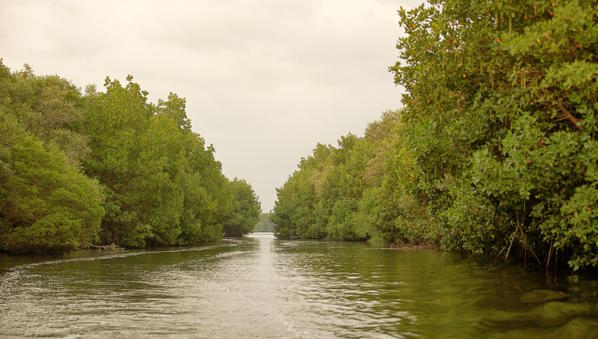
Sri Lankan mangroves respond to conservation plan
Speed read
- The 2004 Asian Tsunami brought home the protective value of Sri Lanka’s mangrove forests
- Mangroves were once being cut down to make way for large-scale shrimp farming — which failed
- A revival begun a year ago has resulted in the revival of about 18,000 hectares of mangroves
A year after Sri Lanka launched a mangrove conservation plan with funds from a U.S. conservation group about half of its 37,000 hectares of mangrove forests are in a various stage of revival, officials say.
With US$ 3.4 million from the Califronia-based Seacology and manpower and other support from the Sri Lankan government, some 283 community organisations have been engaged in the work of conserving and replanting mangrove forests. The national conservation body, Small Fisheries Foundation, is the local implementing partner.
Over the next four years 1,500 community groups will be looking after existing mangroves and also replanting an additional 3,000 hectares. Adding to the efforts, the Sri Lanka Navy has deployed its personnel to help with the planting of over 36,000 mangrove trees.
“Nations within and without the region are taking notice of the Sri Lanka mangrove conservation programme,” Seacology executive director Duane Silverstein tells SciDev.Net.
In July, Sri Lankan President Maithripala Sirisena opened the island’s first mangrove museum in the north-western Chilaw district. The museum expects to attract 20,000 visitors per year.
“There was a time when mangroves were cut for everything from firewood to clearing land for shrimp farms,” Douglas Thisera, director of conservation at the Small Fishers Federation of Sri Lanka, says.
Thisera has been working on conservation for over two decades, from a time when mangroves were actually being cleared with state patronage. Starting from the late 1980s successive governments allowed large businesses to clear mangroves to set up shrimp farms.
What saved the mangroves was the failure of shrimp farming through infections. But, by then, over 40 per cent of mangroves along the north-western coast were destroyed.
The value of mangroves in protection shores was brought home when the December 2004 Asian Tsunami smashed into Sri Lanka’s eastern coast. Mangroves are now protected areas and cutting them down is punishable by law.
Thisera said that the most important component of the programme is community participation. “The community has to value the mangroves, otherwise, they will simply use them for anything they see fit.”
This piece was produced by SciDev.Net’s South Asia desk.
Source: 19/08/2016 :SciDev.Net’s South Asia : http://www.scidev.net/south-asia/conservation/news/sri-lankan-mangroves-respond-to-conservation-plan.html
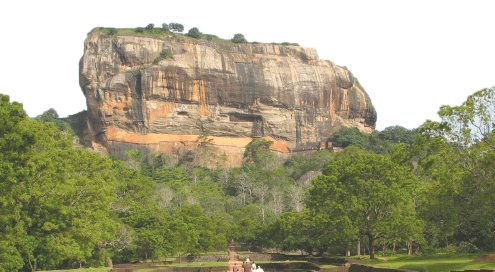
Sigiriya Under Threat
Sri Lanka is a beautiful country filled with nature, forest cover, ecological and water provisions, different species of birds wildlife and so on which also includes several world heritage sites declared by the UNESCO and reserved in the constitution by the government. One may agree the protection of nature and the environment in the nation is only given in the papers and is not implemented.
Sigiriya today is a UNESCO listed World Heritage Site and one of the best preserved examples of ancient urban planning.It is the most visited historic site in Sri Lanka. Destruction under the name of development takes place all around the country to which the environmentalists and the conservationists were unhappy of the plans of government as all projects in common, destroy the nature and the archeological values of them.
According to the ancient Sri Lankan record the Culavamsa, this site was selected by King Kasyapa (477 – 495 CE) for his new capital. He built his palace on the top of this rock and decorated its sides with colourful frescoes. On a small plateau about halfway up the side of this rock he built a gateway in the form of an enormous lion. The name of this place is derived from this structure the Lion Rock. The capital and the royal palace were abandoned after the king’s death. It was used as a Buddhist monastery until the 14th century.
Sigiriya is an ancient rock fortress located in the central Matale District near the town of Dambulla in the Central Province, Sri Lanka. The name refers to a site of historical and archaeological significance that is dominated by a massive column of rock nearly 200 meters (660 ft.) high. The rock fortress is now under threat as nearly 15 acres of forest cover of the sanctuary has been cleared for luxury hotel constructions. Measures were in place to begin the constructions but were put on hold as the villagers and the environmentalists began objecting to the move with the support of the Central Environmental Authority (CEA), Department of Wildlife Conservation (DWC), and Department of Forest Conservation (DFC)just two years ago. Nevertheless, they have recently started the deforestation for hotel construction giving it a fresh start.
It is claimed that leading businessmen who were backed by the higher rank politicians of the country are involved in the luxury tourism hotel constructions.
From where exactly is the authorisation given to such businessmen and politicians, is the unanswered question that remains since the environmental issues began in the country. It is a sanctuary and more of a reserved place since 1993 and was protected and preserved for more than two decades. It is an valuable site since it was recognised as one of the world heritage sites of the country. The cause for the hotel construction within the buffer zone of the Sigiriya is to attract more tourists into the country apparently, causing destruction to a site that has such archeological values for nearly 800 years will not increase the percentage of tourists that come into the country, the environmentalists lamented.
It is pathetic that the government turns a blind eye to the destruction and if the authorities in charge of protecting the nature and the archeological sites of the country are properly acting against the corruption and the violation it can be stopped, the environmentalists claim. There are enough legislations and regulations vested in the constitution to protect the reservations of the country and there is no necessity to increase or include new laws but to implement them. “Implementation is what matters the most when it comes to the protection of nature or any laws in the country,” the Director for Center of Environment and Nature Studies (CENS) Ravindra Kariyawasam stated.
According to the Flora and Fauna Protection Ordinance (FFPO) the ordinance even prohibits the entry of the public or anyone with no proper permits, but how did these businessmen manage to get into the illegal clearing of forests and the clearing of economically valuable trees such as Kubuk, questioned the environmentalists. A numbers of trees which were older than 200 to 400 years were destroyed during the deforestation whereas they should be protected as the forest area is a reservation of the country.
“There are lands that belong to the WDC and the DFC within the buffer zone of Sigiriya and had been cleared by burning and cutting the valuable older trees which will take another 100 years to recreate the nature and it is an absolute destruction done to the valuable assets of the nation,” Kariyawasam said.
Not only is the buffer zone and the sanctuary being affected by the irresponsible tourism project construction but also the wildlife, the birds that live in it and especially the elephants.
There is an elephant path crossing the forest within the Sigiriya archeological site which is one of the most used elephant corridors in the country. We have been educated several times about the escalating Human-Elephant Conflict (HEC) but a solid response is yet to be taken by the government.
In such a backdrop where the trees and the forest cover of the buffer zone is being cleared it also results in affecting the farmers and people who live in the close proximity of Sigiriya as the wild animals enter into the villages and their Chena cultivation areas. It also results in destroying the water resources of the village by cutting down trees and clearing the forests for hotel constructions.
The government is concerned about the major projects in the country but not the daily lives of poor people and the farmers. This might even lead the farmers to leave their native place if they could not continue with their farming and cultivation. The environmentalists request the government to look into the destruction taking place in the country under the name of development and to ensure that the National Environmental Act (NEA) and the FFPO to protect the environment and the archeological sites are implemented and take action if violated.
However, the Sigiriya and its buffer zone had been under threat since the Rajapaksa regime as they were in search of treasures including a few of the archeological sites in the country. The site was damaged by the archeological department itself under the directives of the Rajapaksa regime for treasures. Even though the search for treasures has been stopped under the new government, the destruction of nature has not been stopped.
Nevertheless, it is important to assess the impacts of the destruction and its results before any projects or development is being done within the reservation of the country to ensure their safety. An Environment Impact Assessment (EIA)is a crucial report that should be conducted before any changes are done to the reservations, but no such reports were conducted regarding the Sigiriya hotel constructions. It is also obvious that the reports will be against the hotel projects as it definitely would harm the archeological site.
The environmentalists alleged if they can destroy the reservations without any permission from relevant authorities they should be either an individual or a group of people who are backed by influential politicians of the government and the President as the Minister for environment should consider to protect the nature and to implement the laws. However, when contacted by The Sunday Leader the Director General of the Archeological Department of Sri Lanka Senarath Dissanayake said that the department is unaware of 15 acres of land being cleared within the buffer zones of Sigiriya for hotel constructions, and will look into the matter very soon.
Source : 14/08/2016 The Sunday Leader http://www.thesundayleader.lk/2016/08/14/sigiriya-under-threat/
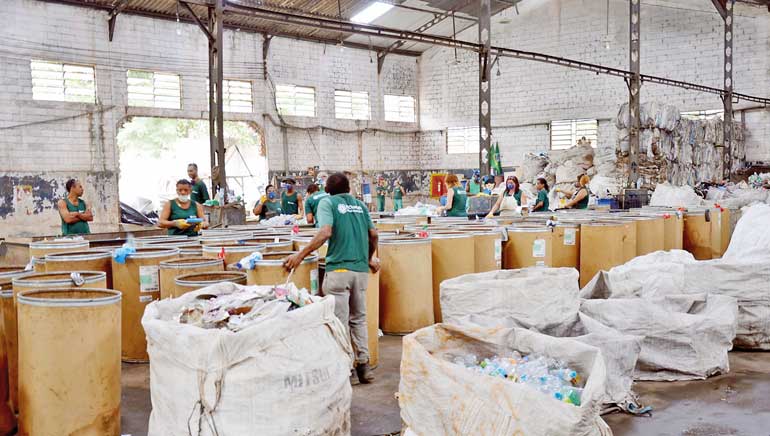
Sustainability now: Let’s leave the waste stigma behind
(Ecco Ponto co-operative’s depot, where Rio 2016’s waste pickers will sort through recyclable goods from the Games )
Despite the controversies associated with the Rio 2016 Olympics, some news seem promising.
Recently the Guardian Newspaper has shared an article on the experiences of Brazilian waste pickers who faced severe stigma due to their occupation before being formally contracted to handle recyclable waste during the Olympic Games 2016 within a program started by Rio 2016, a large corporate and the Brazilian Government. They now earn more than double per day in addition to their share from the sale of the recyclable goods.
Hiring the waste pickers cost the organisers the same as hiring a private cleaning business, however with a much great social benefit. It is estimated that the pickers would be handling not less than 3,500 tons of recyclables over the course of the games.
In neighbouring India, occupations related to waste are still linked to stigma where even the envisioned profit from recycling or waste to energy cannot convince many businesses to engage in this sector, therefore being a barrier to innovative waste management solutions which India desperately needs.
In Sri Lanka we have a number of waste pickers who are sometimes independent and sometimes linked to the CMC or private companies. Where the corporate side of the waste management system seems respected, the waste pickers themselves face a similar situation as their counterparts in other countries. Their services are hardly recognised. Their contribution to less landfill (when segregating the recyclable items from the rest) and clean roads and public spaces is not sufficiently appreciated – yet no one of us would want to imagine a Sri Lanka without waste collectors.
Some weeks back I have visited a kids’ movie premiere in one of the renowned Colombo cinemas which was very well attended, by children and parents. After the movie finished and visitors left, the auditorium was covered in waste. Milk and juice was spilled on seats and the entire floor between the rows was filled with packaging, food and drink items. The carelessness of the visitors was shocking.
What about the educational effect on the children, who learn from small age onwards that littering in such a way is actually ok? That we have the “right to litter” to which extent we feel and someone else will come and clean it up anyways? That it is actually a part of entertainment and events to litter. The cinema cleaning team despite their efforts was not able to clean the venue until the next movie started.
It happens in each country that some people couldn’t care less about a clean environment; however the degree of littering and unsustainable waste management practices in Sri Lanka is shockingly high. Each spot where buses and vans hold for lunch breaks or people gather, even along the roads where intercity buses run, a vast amount of litter can be found. Why is that?
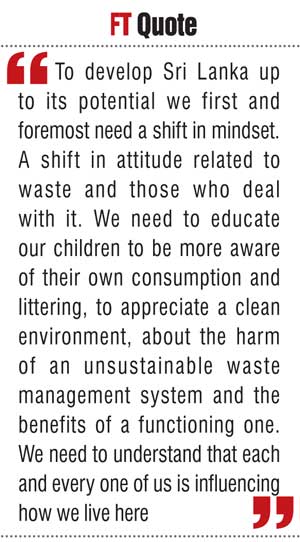 Sometimes there might not be bins available at certain places especially outside the cities, however instead of throwing the garbage on the ground or into the sea, why not keeping a bag and taking it to the next bin (as it is practiced in other countries)? One person’s litter can be easily taken, however as soon as even a small amount is disposed into the nature, other people see the spot as dumping ground and they continue to add their litter.
Sometimes there might not be bins available at certain places especially outside the cities, however instead of throwing the garbage on the ground or into the sea, why not keeping a bag and taking it to the next bin (as it is practiced in other countries)? One person’s litter can be easily taken, however as soon as even a small amount is disposed into the nature, other people see the spot as dumping ground and they continue to add their litter.
It seems that it is self-understood that someone else comes and cleans our dirt. And if not, it also doesn’t matter much, because we will then burn it or dump it somewhere where we can’t see it anymore – neglecting the fact that our waste behaviour is already backfiring on us – be it via the ground water, the soil and vegetables as well as animals we consume or air pollution.
In Sri Lanka we are very particular about what we are and foremost what we are not – an employee at an office or shop will rarely bend to pick up a piece of litter on the ground, the cleaning person needs to come to pick it up. We are too “good” for it.
Talking to officials within waste management organisations reveals that it is the prevailing opinion of residents that the sole responsibility for waste management lies with the respective organisations; even educational and awareness raising efforts to include the citizens in keeping our country clean fail due to this widespread attitude. Still, complaining and sometimes drowning in waste is perceived better than becoming active ourselves.
It is self-understood that each country needs a comprehensive waste management system which includes primarily government, private companies and civil society organisations. However a successful waste management system is heavily dependent on the contribution of each and every citizen starting from consumption patterns, ending with disposal behaviour.
In other countries, citizens are fined for not segregating or for littering. There is one way of introducing and executing strict laws, there is another one to increase the understanding of the harm of unsustainable waste disposal for each and every one, and the benefits of a sustainable system.
To develop Sri Lanka up to its potential we first and foremost need a shift in mindset. A shift in attitude related to waste and those who deal with it. We need to educate our children to be more aware of their own consumption and littering, to appreciate a clean environment, about the harm of an unsustainable waste management system and the benefits of a functioning one. We need to understand that each and every one of us is influencing how we live here.
Where it is the main responsibility of organisations to set up a solid system, we also have to contribute to it: in terms of segregation, recycling, not littering on roads, parks and other public spaces or less consumption overall. It is a bit of a chicken and egg situation; who needs to start – organisations or consumers? Truth is both! There will be only change if we understand our own responsibility as consumers and as citizens.
Sri Lanka is one of the most beautiful and bio-diverse countries in Asia, if not globally, including extensive fauna and flora which is admired by those living here and those visiting. It is not only our human nature to live atone with a healthy environment, it is also our duty as citizens to contribute to a clean and zero-waste Sri Lanka. If others can do it, why not us?
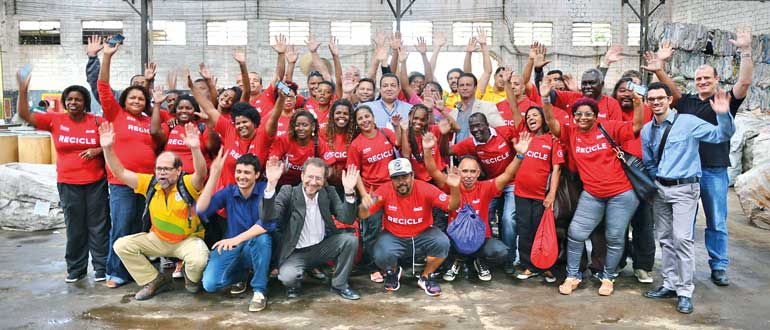
(Rio 2016’s waste pickers)
Source : 10/08/2016 Daily FT: http://www.ft.lk/article/560368/Sustainability-now–Let-s-leave-the-waste-stigma-behind#sthash.KrPEI8TH.dpuf
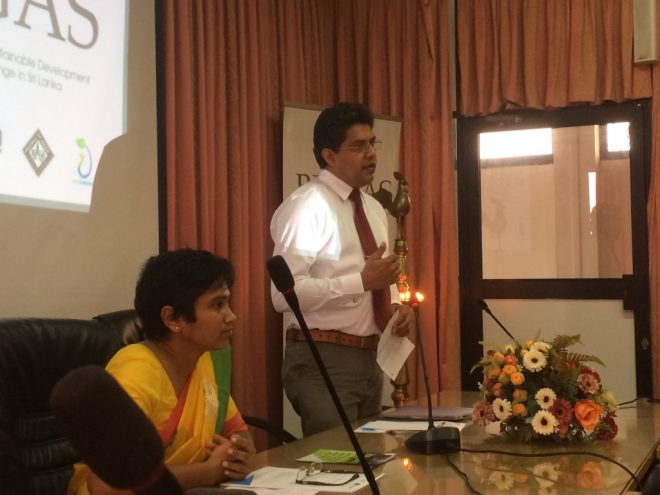
Promoting Biogas among Local Technical Officers for Greener and Sustainable…
Promoting Biogas among Local Technical Officers for Greener and Sustainable Construction Efforts
Janathakshan Gte Ltd and People in Need, Cz conducted a biogas awareness and promotional workshop on renewable energy, biogas and waste management for 65 technical officers recently at the Western Province Waste Management Authority. The technical officers belonged to local authorities in Western Province and are those in-charge of construction. The workshop was conducted under the EU-funded SWITCH Asia initiative on “Up-scaling Biogas Technology for Sustainable Development and Mitigating Climate Change in Sri Lanka”.
The workshop focused on the importance of addressing the Food, Energy and Environment or FEE crises, the impact of increased personal consumption against the decreasing amount of natural resources and the availability of biogas technology as an alternative to a civilisation heavily dependent on fossil fuels.
“Biogas technology used to be popular a few decades back but with a different intent of when there was less access to electricity. However, priorities have changed today and we have shifted from gaining access to electricity to trying to manage waste in limited land area.With this training designed for construction officers in biogas units we hope that the units constructed at local authority level will be doneat higher quality standards,” said Project Manager DamithaSamarakoon.
The Project’s objectives includes creating partnerships in the five select project areas in order to not only ensure sustainability of the project following the project period but also to empower local authorities in the promotion of biogas in their localities.
“It’s important for us to start a large scale project on managing waste in Western Province. We should be able to recycle at least 30% of the degradable waste collected given that 60% of waste is already degradable especially if segregated at disposal,” said Waste Management Authority Director NalinManapperuma.
Adding to his statement was Waste Management Authority Chairman RuviniNadeeshaDharmasiri who believed that it was important “we switch to technologies such as biogas in order to recycle without making more use of existing water resources.”
The project is focused on up-scaling biogas technologies for sustainable development, responsible tourism, economic growth contributing to poverty reduction and climate change mitigation in Sri Lanka. The project targets tourism Small and Medium Enterprises (SMEs), households and public authorities in the country while building the technical capacity of manufacture and construction SMEs in biogas technologies. The EU SWITCH-Asia initiative assists tourism SMEs and households benefit from sustainable solid waste management and cost savings through energy and resource efficiency. Tourism SMEs adopting “green” technology will also increase their marketing potential and gain the access to “green finances” provided by micro-finance institutions.
Source:08/08/2016 Lanka Business online http://www.lankabusinessonline.com/promoting-biogas-among-local-technical-officers-for-greener-and-sustainable-construction-efforts/

Urban landscaping with root balled trees a green-wash?
-tas-2.jpg)
Any national level project focusing environmental improvements through tree plantation should be based on increasing the total tree cover of the country at national level rather than shifting trees from one place to another as currently practiced through root balling methods for our urban landscaping programs. This root balling process also damages the environment of the original location as well, because of disturbance to other plants around it during balling operation. Also the root balled trees are very expensive when compared with the maintenance cost of a small plant to achieve the same height in a nursery.
Also the survival rate of root balled trees is also very low because of difficulty in adapting to new environment.Even newly planted trees have to be maintained at for least for six months to establish its roots to the new environment. This is very difficult task for root balled big trees because they are accustomed to original environment for long time. This is also a very expensive operation for plantation on a large scale like avenue planting in urban landscaping projects. However, this is not so for small plants about 2-3 ft. height grown in nurseries.
Another issue is the sustainability of newly planted trees. If someone takes interest of evaluating the sustainability rate of trees planted in these so called Tree Planting Campaigns inaugurated by politicians you can understand what I am trying to convey. I am sure it is less than 10% because of lack of maintenance after the inauguration. Maintenance should be done by regular watering and fertilizing at least for three months. Otherwise those inaugurations are simply Green Washing programs cheating ourselves.
I think above facts should be taken into consideration in planting trees in urban landscaping programs now in progress in Colombo City. Otherwise it could be a green-wash similar to whitewash.
Foliage planted in front of Temple Trees is a good example of such waste. My layman’s view is that plants grown in nurseries should be promoted for national level projects.
It is only a matter of maintaining those plants for some time until it grows to a safe height beyond which it is self-sustaining. It will help small scale nursery owners too.
Perhaps experts will shed light on this issue?
source :The Island 2016/08/06 http://www.island.lk/index.php?page_cat=article-details&page=article-details&code_title=149892













